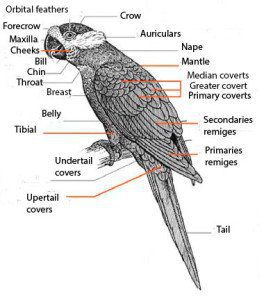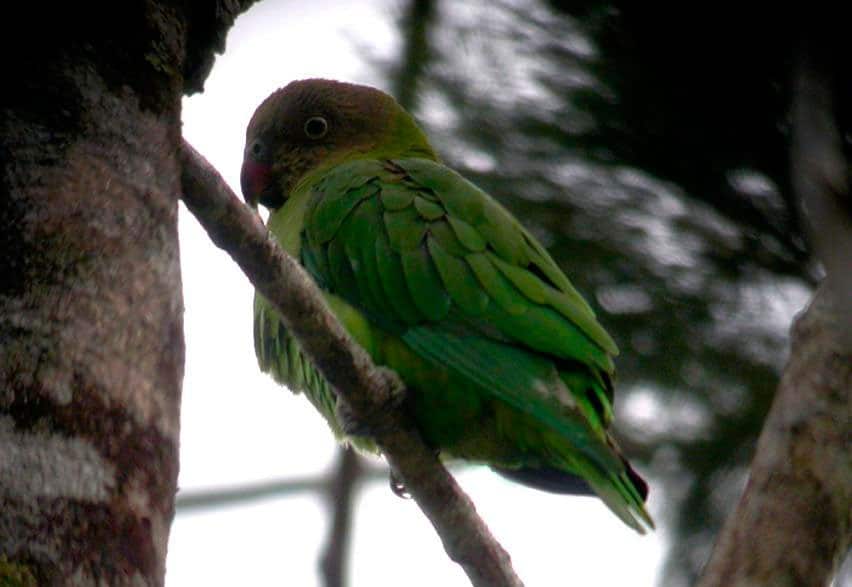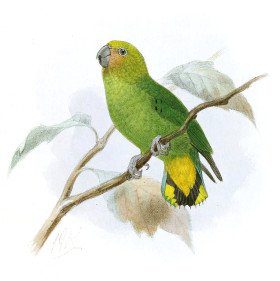Content
|
|---|
Description
9,5 cm. length between 11 and 14 g. of weight.
The crown of the Yellow-capped Pygmy-Parrot (Micropsitta keiensis) is yellow ocher, with a warm brown in forecrown; lores, chin and area under the eyes, brown; coverts outpus, dark green, tending to lighter green on cheeks and throat.
Upperparts, dark green with center at wing-coverts and feathers of black color with a black colored margin extrecho; flight feather black with vane Green external; feathers wings green. The underparts are yellowish-green, with fine dark stripes; undertail-coverts yellow and green. Upper, the tail It is iridescent, slightly greenish blue in the Center, Foreign feathers blackish with yellow spot on the ends. Under, the tail dark blue and yellow.
Bill dark grey; irises brown; legs dark gray.
Both sexes similar.
Immature like females but with bill pale yellow.
- Sound of the Yellow-capped Pygmy-Parrot.
Description 3 subspecies
-
(Salvadori, 1876) – the subspecies nominal.
Micropsitta keiensis keiensis
-
(Rothschild, 1911) – Similar a nominal, but darker.
Micropsitta keiensis viridipectus
-
(Oberholser, 1917) – The mature more muted. The underparts with red markings male, dyed yellowish in female.
Micropsitta keiensis chloroxantha
Habitat:
It inhabits in the forests of lowlands, in secondary growth and, sometimes around inhabited areas and coconut trees. The ecology species is similar to that of the Buff-faced Pygmy-Parrot. The birds are alone, in pairs or in small groups, and they can be distributed by undergrowth to some 20 meters above the ground. They climb on trunks and branches, and they can go down head, in inverted position, sometimes.
Reproduction:
Nest and roost Termites in tree cavities, they excavate the cavity by themselves; tunnel passageways go up and may bend before reaching nest-chamber. up the laying two white eggs deposited in a cavity unlined (dimensions around 20 cm x 15 cm.), and they can be occupied by other adults roost (up to four) during the breeding season. The exact role of these visiting birds is unknown, It is thought that they can help with the tasks of nest. nesting It has been recorded from October to March
Food:
With feed lichen, fungi, seeds, fruits and insects. Most of the lichen is collected directly from the surface of the bark of trees..
Distribution:
Size of its range (breeding/resident): 763.000 km2
The Yellow-capped Pygmy-Parrot is distributed among the papuan islands, in the West area, including Waigeo, give, Kofiau, Salawati and Misool; through Vogelkop and Onin Peninsula (Province of West Papua); in the Kai and islas Aru, and in the South of New Guinea between Mimika and the fly river. The species is common to local scale.
Distribution 3 subspecies:
-
(Salvadori, 1876) – The subspecies nominal.
Micropsitta keiensis keiensis
-
(Rothschild, 1911) – South of New Guinea.
Micropsitta keiensis viridipectus
-
(Oberholser, 1917) – Archipelago Raja Ampat and West New Guinea;
Micropsitta keiensis chloroxantha
Conservation:
• Current IUCN Red List category: Least concern
• Population trend: Stable
The size of the world population It has not been quantified, It is estimated over the 100,000 specimens.
The species, according to sources, It is considered very common within its range (pit et to the. 1997).
The population suspected to be stable in the absence of evidence of any reduction or substantial threats.
"Yellow-capped Pygmy-Parrot" in captivity:
Not usually survive in captivity.
Alternative names:
– Yellow-capped Pygmy-Parrot, Yellow capped Pygmy Parrot, Yellow-capped Pygmy Parrot (ingles).
– Micropsitte pygmée (French).
– Gelbkappen-Spechtpapagei (German).
– Micropsitta keiensis (Portuguese).
– Microloro de Kai, Microloro de las Kai (español).
scientific classification:
– Order: Psittaciformes
– Family: Psittaculidae
– Scientific name: Micropsitta keiensis
– Citation: (Salvadori, 1876)
– Protonimo: Nasiterna keiensis
Images “Yellow-capped Pygmy-Parrot”:
Videos “Yellow-capped Pygmy-Parrot”:
————————————————————————————————
Yellow-capped Pygmy-Parrot (Micropsitta keiensis)
Sources:
– Avibase
– Parrots of the World – Forshaw Joseph M
– Parrots A Guide to the Parrots of the World – Tony Juniper & Mike Parr
– Birdlife
– Photos:
(1) – Parrot-birds – link
(2) – « NasiternaPygmaeaFKeulemans » par John Gerrard Keulemans — Ornithological Miscellany. Volume 1. Licensed public via domain Wikimedia Commons.
– Sounds: Hans Matheve (Xeno-canto)


